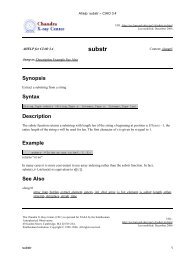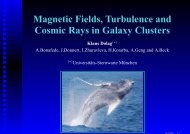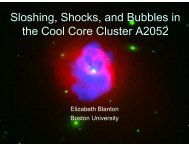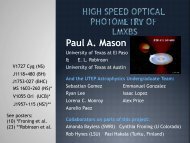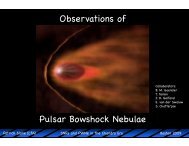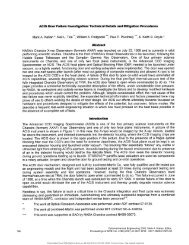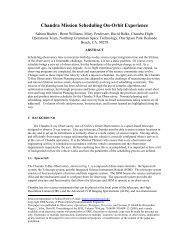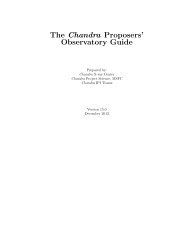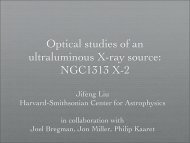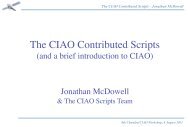PDF Version - Chandra X-Ray Observatory (CXC)
PDF Version - Chandra X-Ray Observatory (CXC)
PDF Version - Chandra X-Ray Observatory (CXC)
Create successful ePaper yourself
Turn your PDF publications into a flip-book with our unique Google optimized e-Paper software.
Spring, 2012<br />
A Close Nuclear Black Hole Pair<br />
in the Spiral Galaxy NGC3393<br />
Exploring the inner regions of active galaxies<br />
with the highest <strong>Chandra</strong> resolution<br />
G. Fabbiano<br />
The discovery of the M-sigma relation 1 , the correlation<br />
between the masses of galaxy bulges and those of nuclear<br />
massive black holes (MBHs), has suggested that the evolution<br />
of galaxies and their MBHs are linked. Both are thought<br />
to grow and evolve by merging of smaller galaxy/MBH units<br />
pulled together by gravity (see review 2 ). During this process,<br />
MBHs may also accrete stars and interstellar medium (ISM)<br />
from the surrounding merger galaxy, causing the MBH to<br />
grow and to “shine” as an active galactic nucleus (AGN). Radiation<br />
and winds from the active MBH—AGN feedback—<br />
may in turn provide a crucial regulatory mechanism for both<br />
galaxy and MBH/AGN growth 3 .<br />
The above scenario is consistent with the growing<br />
body of multi-wavelength observations, and has been<br />
validated by increasingly sophisticated theoretical simulations<br />
4,5 . However, it includes also a big pinch of guesswork.<br />
Two open questions stand out: (1) What are the physical parameters<br />
of AGN feedback? (2) Can we set strong observational<br />
constraints on MBH merger evolution?<br />
Since AGNs are easily detected in X-rays, <strong>Chandra</strong><br />
can play an important role in pursuing these questions at the<br />
heart of galaxy evolution.<br />
In this report I will discuss how our project to set observational<br />
constraints on AGN feedback with <strong>Chandra</strong> has<br />
Fig. 1- Deconvolved<br />
HRC image 9 , compared<br />
with [OIII]<br />
contours from the<br />
HST/FOC (white<br />
contours). The letters<br />
in the image<br />
refer to the regions<br />
labeled in the subpixel<br />
ACIS image<br />
shown in Fig. 2.<br />
Pushing <strong>Chandra</strong>’s Resolution to its Limit: NGC4151<br />
also led to the discovery of a merging pair of active MBHs,<br />
providing a direct observation of later merger evolution.<br />
<strong>Chandra</strong> observations have shown the entire gamut<br />
of nuclear activity from luminous quasars to “silent” or<br />
quasi-silent nuclear MBHs 6 . The effect of past AGN activity<br />
on the surrounding hot gaseous medium is evident in the<br />
large-scale (several to 100s kpc) loops and rings discovered<br />
in <strong>Chandra</strong> images of giant elliptical galaxies and clusters 7 .<br />
Merger-triggered MBH activity was first imaged with <strong>Chandra</strong><br />
in NGC6240, where a ~2 kpc separation double AGN<br />
was discovered, both sources with prominent Fe-Kα lines 8 in<br />
their X-ray spectra.<br />
Until recently, these studies were missing the inner<br />
(≤100 pc scale) regions of nearby galaxies hosting luminous<br />
AGNs, because of the instrumental constraints of ACIS, the<br />
most commonly used <strong>Chandra</strong> detector: the imaging resolution<br />
limits imposed by the ½ arcsec instrument pixel and<br />
the relatively slow ACIS readout resulting in ‘pileup’ of the<br />
strong point-like sources associated with luminous nearby<br />
AGNs. However, these inner regions are where we would<br />
have the best chance of setting direct observational constraints<br />
on the physical parameters of AGN feedback from<br />
currently active MBHs, as well as observing active MBHs in<br />
a later stage of merging.<br />
In the attempt to investigate the inner circum-nuclear<br />
regions of AGNs, post-doc Junfeng Wang, Martin Elvis,<br />
Guido Risaliti and I have observed some of these nuclei<br />
with the HRC, which although less sensitive and without<br />
the energy resolution of ACIS, samples adequately the mirror<br />
PSF and is not affected by pileup. We have also acquired<br />
deep ACIS data and imaged it with sub-pixel binning (see<br />
insert).<br />
3<br />
Our pilot target was NGC4151 (at a distance<br />
of 13.3 Mpc). We obtained new deep HRC<br />
and ACIS data, which we analyzed in conjunction<br />
to the data already available in the <strong>Chandra</strong><br />
archive. The HRC data allows a clean view of the<br />
innermost circum-nuclear region (1”~65 pc),<br />
which in ACIS is affected by pileup. The HRC<br />
instrumental pixel also oversamples the <strong>Chandra</strong><br />
telescope (HRMA) PSF, and therefore the HRC<br />
images, although devoid of spectral information,<br />
are of a resolution comparable to the limits of<br />
the <strong>Chandra</strong> mirrors. The HRC+mirror PSF is<br />
well calibrated, allowing image deconvolution to<br />
minimize the effect of the PSF wings of the strong<br />
nuclear source on the extended circum-nuclear<br />
emission 9 . Fig. 1 shows how several features of<br />
the deconvolved HRC image of NGC4151 closely



